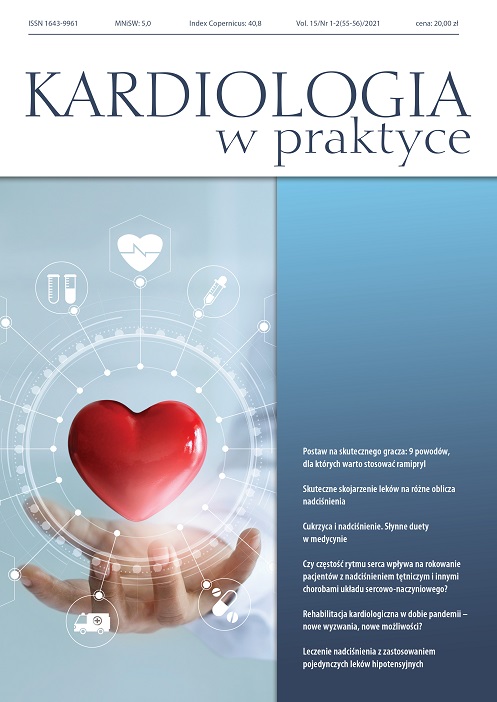Czy częstość rytmu serca wpływa na rokowanie pacjentów z nadciśnieniem tętniczym i innymi chorobami układu sercowo-naczyniowego? Artykuł przeglądowy
##plugins.themes.bootstrap3.article.main##
Abstrakt
Podwyższona częstość rytmu serca zarówno w populacji osób zdrowych, jak i u pacjentów z chorobami układu krążenia w istotny sposób zwiększa ryzyko powikłań sercowo-naczyniowych. Podwyższoną częstość rytmu serca spotyka się u wysokiego odsetka chorych na nadciśnienie tętnicze. Konieczna jest wczesna identyfikacja chorych z tachykardią i ich terapii. Wśród leków stosowanych w leczeniu przyspieszonej częstości rytmu serca szczególne miejsce zajmują β-adrenolityki. Ponieważ w terapii nadciśnienia tętniczego są zalecane leki złożone, warto rozważać stosowanie połączenia bisoprololu i peryndoprylu. W licznych badaniach udowodniono skuteczność tych leków w ograniczaniu powikłań sercowo-naczyniowych w różnych grupach pacjentów.
Pobrania
##plugins.themes.bootstrap3.article.details##

Utwór dostępny jest na licencji Creative Commons Uznanie autorstwa – Użycie niekomercyjne – Bez utworów zależnych 4.0 Międzynarodowe.
Copyright: © Medical Education sp. z o.o. This is an Open Access article distributed under the terms of the Attribution-NonCommercial 4.0 International (CC BY-NC 4.0). License (https://creativecommons.org/licenses/by-nc/4.0/), allowing third parties to copy and redistribute the material in any medium or format and to remix, transform, and build upon the material, provided the original work is properly cited and states its license.
Address reprint requests to: Medical Education, Marcin Kuźma (marcin.kuzma@mededu.pl)
Bibliografia
2. Quer G, Gouda P, Galarnyk M et al. Inter- and intraindividual variability in daily resting heart rate and its associations with age, sex, sleep, BMI, and time of year: Retrospective, longitudinal cohort study of 92,457 adults. PLoS One. 2020; 15(2): e0227709.
3. Levy RL, White PD. Transient tachycardia; prognostic significance alone and in association with transient hypertension. Med Press Egypt. 1946; 38(6): 207-12.
4. Inoue T, Oshiro S, Iseki K et al. High heart rate relates to clustering of cardiovascular risk factors in a screened cohort. Jpn Circ J. 2001; 65(11): 969-73.
5. Palatini P, Dorigatti F, Zaetta V et al. Heart rate as a predictor of development of sustained hypertension in subjects screened for stage 1 hypertension: the HARVEST Study. J Hypertens. 2006; 24(9): 1873-80.
6. Farinaro E, Stranges S, Guglielmucci G et al. Heart rate as a risk factor in hypertensive individuals. The Italian TensioPulse Study. Nutr Metab Cardiovasc Dis. 1999; 9(4): 196-202.
7. Morcet JF, Safar M, Thomas F et al. Associations between heart rate and other risk factors in a large French population. J Hypertens. 1999; 17(12 Pt 1): 1671-6.
8. Palatini P, Julius S. Relevance of heart rate as a risk factor in hypertension. Curr Hypertens Rep. 1999; 1(3): 219-24.
9. Julius S, Palatini P, Kjeldsen SE et al. Usefulness of heart rate to predict cardiac events in treated patients with high-risk systemic hypertension. Am J Cardiol. 2012; 109(5): 685-92.
10. Jouven X, Zureik M, Desnos M et al. Resting heart rate as a predictive risk factor for sudden death in middle-aged men. Cardiovasc Res. 2001; 50(2): 373-8.
11. Gillman MW, Kannel WB, Belanger A et al. Influence of heart rate on mortality among persons with hypertension: the Framingham Study. Am Heart J. 1993; 125(4): 1148-54.
12. King DE, Everett CJ, Mainous AG et al. Long-term prognostic value of resting heart rate in subjects with prehypertension. Am J Hypertens. 2006; 19(8): 796-800.
13. Diaz A, Bourassa MG, Guertin MC et al. Long-term prognostic value of resting heart rate in patients with suspected or proven coronary artery disease. Eur Heart J. 2005; 26(10): 967-74.
14. Fox K, Ford I, Steg PG et al. Heart rate as a prognostic risk factor in patients with coronary artery disease and left-ventricular systolic dysfunction (BEAUTIFUL): a subgroup analysis of a randomised controlled trial. Lancet. 2008; 372(9641): 817-21.
15. Nabel EG, Selwyn AP, Ganz P. Paradoxical narrowing of atherosclerotic coronary arteries induced by increases in heart rate. Circulation. 1990; 81(3): 850-9.
16. Palatini P, Rosei EA, Casiglia E et al. Management of the hypertensive patient with elevated heart rate: Statement of the Second Consensus Conference endorsed by the European Society of Hypertension. J Hypertens. 2016; 34(5): 813-21.
17. Williams B, Mancia G, Spiering W et al. 2018 Practice Guidelines for the management of arterial hypertension of the European Society of Hypertension and the European Society of Cardiology: ESH/ESC Task Force for the Management of Arterial Hypertension. J Hypertens. 2018; 36(12): 2284-309.
18. The Cardiac Insufficiency Bisoprolol Study II (CIBIS-II): a randomised trial. Lancet. 1999; 353(9146): 9-13.
19. Bertrand ME, Ferrari R, Remme WJ et al. Perindopril and beta-blocker for the prevention of cardiac events and mortality in stable coronary artery disease patients: A EUropean trial on Reduction Of cardiac events with Perindopril in stable coronary Artery disease (EUROPA) subanalysis. Am Heart J. 2015; 170(6): 1092-8.
